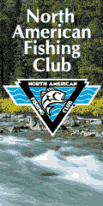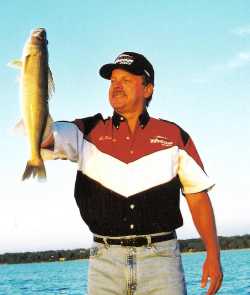
|
|||||
|
Promotional Team Favorites Lodging food and more 
Free 90 day Risk free trial offer click here 
|
By JOHN KOLINSKI
Editor's note: John Kolinski of Menasha, Wis., is a nine-time championship qualifier during his six years of professional fishing on the Professional Walleye Trail and Masters Walleye Circuit. His columns can be found in numerous outdoor publications and at several web addresses. A frequent seminar speaker, Kolinski is sponsored by Triton Boats, Mercury Motors, MinnKota, Lindy/Little Joe and Berkley Trilene. Cool, clear water cascading over a rock ledge, bubbling from a spring or flowing gently along a riverbed is nature at its refreshing best. Unfortunately, that isn't always reality for walleye anglers who travel long distances to fish and are then greeted by muddy rivers, churned-up lakes and wind-swept reservoirs. Succeeding under these conditions requires some patience, some innovation and some flexability, but learning to see clearly regardless of water conditions can keep those walleyes coming into your boat. In some situations, dirty water is an ally that draws walleyes into shallow environments where they are accessible and active. Among the situations I always look for when fishing reservoirs are wind-blown points and shorelines where mud lines set up a few yards offshore. Foremost, these pockets of stained water often attract baitfish because the tiny organisms and zoo plankton they feed on get stirred up and mixed throughout the water column where they are easy to find. In turn, the baitfish become easy targets for predators like walleyes that will follow them into the shallower water. Meanwhile, dark water offers security for light-sensitive fish that might otherwise avoid clear, shallow water. Two presentations excel for this type of fishing -- pitching small jigs and pulling spinners or live-bait rigs. Typically, these mudline areas don't cover more than 30-40 yards, and quarters are too tight to pull crankbaits effectively. Spinners and bait rigs become a better option because they can be fished slower, which helps the angler make the tighter turns necessary to stay on task. I try to work the edges of the mudline where hungry fish often wait to ambush prey that wanders into clearer water and becomes more visible. In some big-water situations, mudlines also signify a difference in water temperature and fish hold along the edges as readily as though it were classic physical structure. Muddy water can hold plenty of walleyes on smaller inland lakes, as well. In some situations, a big blow will stir up an entire section of a lake, or at least some of its bays. Most of these situations occur in water less than eight feet deep, and the become a magnet for baitfish and walleyes because the dirty water tends to absorb and retain heat better than deeper, clearer water. Trolling crankbaits like Storm Thundersticks in brightly colored patterns such as firetiger and chartreuse can be a dynamite presentation. This time of year, dirty water frequently greets anglers on rivers across the Midwest where heavy spring rains eat away at the shorelines and runoff from the surrounding watersheds carries silt into the water. While it's never an ideal situation, there are some tricks and tactics that will still produce fish. Many prespawn anglers head immediately for the tailwaters below the dams in these conditions, and they catch their share of fish although the size is often smaller than we'd like. I suspect that their success is a product of the sheer numbers of walleyes that gather in the tailwaters more than any new migration of fish caused by dirty water. No matter what the time of year, the presence of muddy water, in my opinion, doesn't cause major migrations in the walleye population. The fish are still in the general areas where you found them during cleaner-water periods, although there is generally some movement shallower when the water is rising and deeper when it's falling. My philosophy is to give these fish something they can find.
the precision it provides. Lures can be presented just inches off the bottom and kept where the walleyes can't miss them.. It also allows the angler to target specific sections of structure and keep those lures in the strike zone There is one situation where muddy water is a hindrance that I believe is best avoided altogether. I've encountered big areas of dirty water on Lake Erie and at Saginaw Bay, and although I've often markedgood numbers of fish, I have not been able to entice them to bite. On a couple of occasions, the school of fish has been large enough to stretch beyond the dirty water, and I've found those fish to be active and cooperative. It all comes down to adaptation. Don't let dirty water become mud in your eye. Instead, go get those 'eyes in the mud. Fish Clix Banner Exchange Please visit these site sponsors |
||||
|---|---|---|---|---|---|

